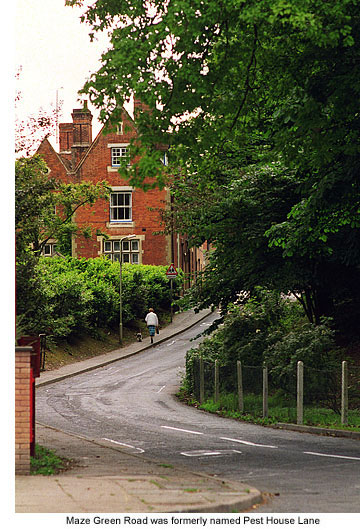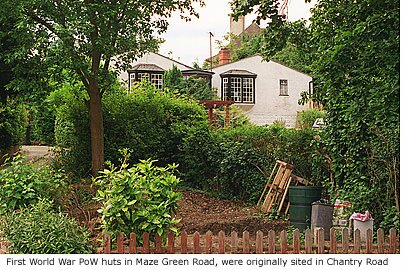
| UPDATES | GUEST BOOK | MEMORIES | MORE PICTURES | OTHER LINKS | BIBLIOGRAPHY | ||

Maze Green Road

According to the notes of former town historian J.L. Glasscock (HALS*), reference to this road first appeared in 1396 when it was called Mesegrene. It has also been referred to as Moresgreen Lane (1645); Musgreen (1649); and Munshall or Musgrene Lane (1671). In 1596 it was also called Wayte Lane because it led from the ancient Waytes Cross to Mase Green [sic].
For a long period of time, however, it was more commonly known as Pest House Lane, the name possibly originating from the 16th century when plague – also known as pestis – struck Bishop’s Stortford. The town was visited by the plague on three occasions in all, the first being the bubonic plague in 1349 of which time there are few records. But at the time of its second visit, between June 1582 and March 1583, it is known to have claimed 60 lives in the area. Those who were ill of plague were segregated and interred a suitable distance away from the town in a building at the top of this road called the Pest House. It is for this reason that we assume Pest House Lane was so named.
There are, however, other suggestions for it being named Pest House Lane, but more particularly Maze Green Road, each of which is equally plausible. In medieval England every town had its Pest – or Lazer – or Leper House situated just outside its boundaries. The name for a Leper was ‘mezel’ (pronounced mazel), and a Leper House would have been called a Lazer House, or Mezel House. By this token, the green at the top of the road may well have been the site of a Leper House and called ‘Mezel (or Mazel) Green’.
Another suggestion is that Maze Green Road was named as a direct result of the plague’s first visit to the town in the 14th century – the medieval word ‘maze’ or ‘mazed’ said to be interpreted as a ‘muddled mind’, which was just one of the effects the disease had on people. It’s feasible, therefore, that the green at the top of this road was used as a place of internment for plague victims and named ‘Maze’ Green for that reason. In fact, both suggestions would tie in with the earliest reference to the road (1396): Mesegrene, as in mezel (pronounced mazel), referring to a Leper House; or Mesegrene, as in Maze Green, referring to the ‘mazed’ effect the 1349 plague had on its victims.
 If this is true, then it would seem the name Pest House Lane originated at the time of the plague’s final and most devastating visit to the town. In the wake of the Great Plague that struck London in 1665, it reached Stortford in July 1666 and raged for a full five months. The church register records 231 related deaths in 1666/67 – at that time one sixth of Bishop’s Stortford’s population – but the total may have been much higher because not all victims were buried in St Michael’s churchyard. Church records also show that during the outbreak, one William Barnard was paid 6d. (2 1/2p) ‘for making of “O Lord have mercy upon us” on doors’.
If this is true, then it would seem the name Pest House Lane originated at the time of the plague’s final and most devastating visit to the town. In the wake of the Great Plague that struck London in 1665, it reached Stortford in July 1666 and raged for a full five months. The church register records 231 related deaths in 1666/67 – at that time one sixth of Bishop’s Stortford’s population – but the total may have been much higher because not all victims were buried in St Michael’s churchyard. Church records also show that during the outbreak, one William Barnard was paid 6d. (2 1/2p) ‘for making of “O Lord have mercy upon us” on doors’.
Despite the Pest House being pulled down in 1834 as a result of the Poor Law Ammendment Act (See Guide 10 – Workhouse), the name Pest House Lane was retained until the late 1800s when its original title was then reinstated – fortunately before the College became fully established. Locally, though, it was still referred to as ‘The Lane’ until the late 1920s. Where the actual Pest House stood later became the site of the town’s water works but in the early 1990s was redeveloped for private housing.
*(HALS) Hertfordshire Archives and Local Studies
 |
||
|
The Plague |
||
|
In 1347 news reached England of a terrible disease that was sweeping the Continent. Named the pestilence, it had seemingly begun on the island of Sicily, devastating the population, then crossed to mainland Italy where it rapidly spread throughout the country causing countless deaths particularly in Florence and Venice. It also crossed the Mediterranean to Marseille, where it established a base, and from there spread throughout northern Europe. |
||
